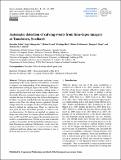Files in this item
Automatic detection of calving events from time-lapse imagery at Tunabreen, Svalbard
Item metadata
| dc.contributor.author | Vallot, Dorothee | |
| dc.contributor.author | Adinugroho, Sigit | |
| dc.contributor.author | Strand, Robin | |
| dc.contributor.author | How, Penelope | |
| dc.contributor.author | Pettersson, Rickard | |
| dc.contributor.author | Benn, Douglas | |
| dc.contributor.author | Hulton, Nicholas R. J. | |
| dc.date.accessioned | 2019-04-10T15:30:03Z | |
| dc.date.available | 2019-04-10T15:30:03Z | |
| dc.date.issued | 2019-03-29 | |
| dc.identifier | 258549414 | |
| dc.identifier | 8c6ac737-5a72-4e2f-a059-a7bdfd356fed | |
| dc.identifier | 000462819000001 | |
| dc.identifier | 85065669220 | |
| dc.identifier | 000462819000001 | |
| dc.identifier.citation | Vallot , D , Adinugroho , S , Strand , R , How , P , Pettersson , R , Benn , D & Hulton , N R J 2019 , ' Automatic detection of calving events from time-lapse imagery at Tunabreen, Svalbard ' , Geoscientific Instrumentation Methods and Data Systems , vol. 8 , no. 1 , pp. 113-127 . https://doi.org/10.5194/gi-8-113-2019 | en |
| dc.identifier.issn | 2193-0856 | |
| dc.identifier.other | ORCID: /0000-0002-3604-0886/work/64697377 | |
| dc.identifier.uri | https://hdl.handle.net/10023/17496 | |
| dc.description.abstract | Calving is an important process in glacier systems terminating in the ocean, and more observations are needed to improve our understanding of the undergoing processes and parameterize calving in larger-scale models. Time-lapse cameras are good tools for monitoring calving fronts of glaciers and they have been used widely where conditions are favourable. However, automatic image analysis to detect and calculate the size of calving events has not been developed so far. Here, we present a method that fills this gap using image analysis tools. First, the calving front is segmented. Second, changes between two images are detected and a mask is produced to delimit the calving event. Third, we calculate the area given the front and camera positions as well as camera characteristics. To illustrate our method, we analyse two image time series from two cameras placed at different locations in 2014 and 2015 and compare the automatic detection results to a manual detection. We find a good match when the weather is favourable, but the method fails with dense fog or high illumination conditions. Furthermore, results show that calving events are more likely to occur (i) close to where subglacial meltwater plumes have been observed to rise at the front and (ii) close to one another. | |
| dc.format.extent | 15 | |
| dc.format.extent | 5590935 | |
| dc.language.iso | eng | |
| dc.relation.ispartof | Geoscientific Instrumentation Methods and Data Systems | en |
| dc.subject | GE Environmental Sciences | en |
| dc.subject | QA75 Electronic computers. Computer science | en |
| dc.subject | NDAS | en |
| dc.subject.lcc | GE | en |
| dc.subject.lcc | QA75 | en |
| dc.title | Automatic detection of calving events from time-lapse imagery at Tunabreen, Svalbard | en |
| dc.type | Journal article | en |
| dc.contributor.institution | University of St Andrews. School of Geography & Sustainable Development | en |
| dc.contributor.institution | University of St Andrews. Bell-Edwards Geographic Data Institute | en |
| dc.identifier.doi | 10.5194/gi-8-113-2019 | |
| dc.description.status | Peer reviewed | en |
This item appears in the following Collection(s)
Items in the St Andrews Research Repository are protected by copyright, with all rights reserved, unless otherwise indicated.

